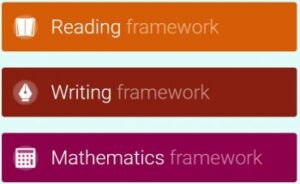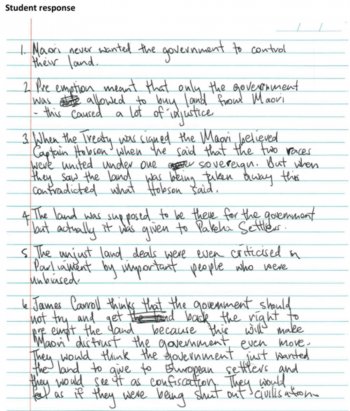The Forgotten Years
By Janelle Stevenson on November 13, 2017 in Assessment tools
Using the Learning Progression Frameworks for literacy learning in Years 9 and 10
Whenever I see or hear the phrase “forgotten years” two things play through my mind: if I’m honest the first thing is the Midnight Oil song, closely followed by the enigma that is teaching, learning and assessment in Years 9 and 10! It seems a bizarre combination at first glance – one a song about the years between two wars, and the other an important growing and learning period – hmm, maybe not so radically different after all.
As many secondary educators know and rue, “forgotten years” is the phrase sometimes applied to Years 9 and 10, in terms of teaching, learning and assessment, although actually these students are one of the most agonised over groups in the secondary sector. When I look back over my years of teaching, students in these years are some of the real characters who spring to mind, as they are finding their identity in the world, and learning to express themselves as adults. Large on the horizons of many of them are years of national assessment, where they will have to read as, and express themselves as, academics in increasingly specialised contexts.
As students transition into and move through the secondary years and NCEA, the reading and writing demands of their chosen subjects become increasingly complex and interwoven with subject content, and students need to be proficient in both to find success.
As I have worked with schools in Otago and Southland this year introducing and implementing the Curriculum Progress Tools, including the Learning Progression Frameworks (LPF) for Reading and Writing, I have seen teachers exploring what the Progressions can offer learners in years 9 and 10 to support their literacy progress. It’s made me clearer about some of the exciting ways the Progressions can support these students and their teachers to be clear about literacy progress across the curriculum.

The Learning Progressions can support students to set what Hattie calls “learning targets” – by clarifying the specific literacy knowledge, skills and behaviours required at each level. In successful learning contexts students and teachers set goals based on data and then explore what success looks like, before clarifying the learning steps to get there. Often we spend considerable time focusing on the “subject” progressions in secondary, and struggle a bit more to analyse the literacy demands and that data in our own subject areas. In 2012 the Education Review Office noted in the conclusion to its report Literacy and Mathematics in Years 9 and 10: using Achievement Information to Promote Success:
“Secondary leaders and teachers urgently need to improve their practice in using literacy and mathematics assessment information for planning, implementing and reviewing the curriculum for all Years 9 and 10 students.”
Achievement and progress is more often than not underpinned by the literacy curriculum which runs across all learning areas, and the Learning Progressions provide rich examples of what reading and writing knowledge, skills and behaviours look like for teachers, students and whānau in cross curricular settings.
As an English and classical studies teacher, I know the importance of student goals being linked to something specific and exemplified – it is after all the way that NCEA works, with clear exemplars of levels of what achievement at Achieved, Merit and Excellence look like. In effective practice, students and teachers together unpack the exemplars and analyse the annotations; the same is possible with the Learning Progressions in terms of literacy demands, and they can lead to the clarification of learning criteria.
The Progressions can support teachers in planning for literacy learning across the curriculum. There have been indications for some time that teachers could do with further support in this. A 2013 report to the Ministry of Education. Literacy and Pedagogy within subject areas in Years 7-11 (A Wilson et al) notes a variety of ways in which teachers consider that they teach literacy, some of which are unsupported by evidence of their efficacy.
The Literacy Progression Frameworks support teachers by providing descriptions and exemplars of the stages of literacy learning, not only under the Core Literacy heading but also under the headings of English, Social Sciences and Science.
Let’s look at an example from the Literacy Progressions Framework
One of the dimensions in the Writing Framework is Using Writing to think and organise learning. Set 6 (the top level of this dimension, applicable to years 9 and 10) provides examples within Core Literacy, English, Science and Social Sciences. In the Social Sciences exemplar, this is how the literacy concepts are explicitly unpacked:
The students independently apply increasingly sophisticated literacy processes, strategies, and frameworks to clarify their thinking and support complex, subject-specific learning purposes. They confidently plan systematic investigations and recording of findings, for example, by generating specific areas or directions for subject-area investigation, evaluating current knowledge, identifying and evaluating possible sources, and developing sets of key words (and sets of synonyms) for search queries.
The students draw on a large repertoire of strategies for summarising, transforming, and organising information and ideas from within and across complex or multiple texts. For example, they select or create retrieval frameworks, such as tables or graphic organisers, on the basis of subject-area purpose and personal preference or utility. They confidently apply strategies for translating quantitative or technical information expressed in words into visual forms, such as diagrams and graphs, and vice versa. They draw on research to plan and write literary texts based on accurate factual information.
This description on its own gives guidelines to teachers and students about what is expected of students at this level of social sciences study.
Additionally and extremely helpfully, the description is supported by a number of examples, one asking students to evaluate the place of The Treaty of Waitangi as the founding document for 21st Century New Zealand by reading a series of quotations about the Treaty, and in particular paraphrasing a note by Sir James Carroll to the 1891 Native Land Laws Commission. The text used is referenced which gives teachers and students an idea of the expected sophistication of texts at this level. The student paraphrase is annotated to clarify how the student has used the strategies described above. But there’s more to this exemplar – what follows therein is something which teachers I’ve worked with this year have found very powerful; there is the transcript of a discussion between the teacher and student. They discuss the literacy behaviours the student has used so the teacher and student can both explore the way of working needed to get to the next level. The teacher asks the student how they went about writing the paraphrase, and why they used bullet points. It is a fantastic and very accessible model of what a conversation centred on the important literacy skill being foregrounded in this piece of work sounds like, in this case in social sciences, but there are rich examples in science and English too.

So you can see that the Progressions can be used by teachers and students in Years 9 and 10 to support literacy learning. Students can use the Progressions to self-assess and use the subsequent sets to provide next steps in literacy learning, or, in Hattie’s words, a learning target related to literacy. For example, “My response is best described by the annotations on Set 5 – so I’m looking ahead to Set 6 to clarify my next learning steps, and that is what I will ask my teacher for guidance with in terms of my specific literacy learning goal.” The Progressions also guide the teacher in terms of what literacy knowledge, skills and behaviours they can and should be explicit about with learners.
These Progressions are the latest and best understanding of the steps students take as they work their way through the literacy demands of the curriculum. They can help teachers and students navigate through, not so much the “forgotten years” but, as Midnight Oil also called them in their lyrics, “the years between ….the hardest years, the wildest years …these should not be forgotten years”.
References:
Learning Progression Framework
https://curriculumprogresstools.education.govt.nz/
Literacy and Mathematics in Years 9 and 10: using Achievement Information to Promote Success, Education Review Office, July 2012
Literacy and Language Pedagogy Within Subject Areas in Years 7-11 A Wilson, Dr R Jesson, N Rosedale and V Cockle, Woolf Fisher Research Centre, University of Auckland, April 2013
The Forgotten Years From the album Blue Sky Mining, 1990 by Midnight Oil
Reach out to Janelle and our team to learn more
Other articles you might like
There are a number of reasons why your choice of e-asTTle prompt is important. I have outlined 9 of these below. I know from my work with schools that many of you do have questions regarding this assessment tool.
A great starting place… But then what?
Active learners – learners who are able to take ownership of their own learning – are becoming successful lifelong learners.
